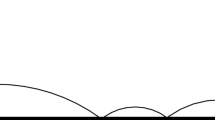Abstract
By an “ideal gas” we mean a gas which formally does not depend on the form of the interaction between the particles. We construct the thermodynamics (the equation of state) of such a gas, and this thermodynamics depends on three parameters corresponding to the Zeno-line and to the value of the compressibility factor Z at the critical point (a three-parameter family of three-dimensional Lagrangian manifolds).
Similar content being viewed by others
References
V. P. Maslov, “A Note to the Report of I. M. Gel’fand,” Uspekhi Mat. Nauk 23(2), (1968) [in Russian].
V. P. Maslov, S. A. Molchanov, and A. Ya. Gordon, “Behavior of Generalized Eigenfunctions at Infinity and the Schrödinger Conjecture,” Russ. J. Math. Phys. 1(1), 71–104 (1993).
V. V. Kozlov, Thermal Equilibrium in the Sense of Gibbs and Poincaré (Regulyarnaya i Khaoticheskaya Dinamika, Moskva-Izhevsk, 2002) [in Russian].
V. V. Kozlov, “Kinetics of Collisionless Gas: Equalization of Temperature, Growth of the Coarse-Grained Entropy and the Gibbs Paradox,” Regul. Chaotic Dyn. 14(4–5), 535–540 (2009).
V. P. Maslov, “Comparison of the Supercritical States of Fluids for Imperfect Gases and for a Fractal Ideal Gas,” Math. Notes 87(3–4), 303–310 (2010).
V. P. Maslov, The λ-Point in Helium-4 and Nonholonomic Clusters, Math. Notes, 87(1–2), 298–300 (2010).
V. P. Maslov, Threshold Levels in Economics (arXiv:0903.4783v2 [q-fin.ST]).
V. P. Maslov, On Refinement of Several Physical Notions and Solution of the Problem of Fluids for Supercritical States (arXiv:0912.5011v2 [cond-mat.stat-mech]).
V. P. Maslov, “Dequantization, Statistical Mechanics, and Econophysics,” in Contemporary Mathematics (Amer. Math. Soc., Providence, RI, 2009), Vol. 495, pp. 239–279.
V. P. Maslov, Perturbation Theory and Asymptotical Methods (Izd. Moskov. Univ., Moscow, 1965; Dunod, Paris, 1972) [in Russian and French].
G. Parisi and F. Zamponi. “A Replica Approach to Glassy Hard Spheres,” J. Stat. Mech. Theory Exp., P03026(03), 1–15 (2009).
L. Berthier and T. Witten, Compressing Nearly Hard Sphere Fluids Increases Glass Fragility (see Arxiv, arXiv:0810.4405v2 [cond-mat.stat-mech] 12 Mar 2009).
V. I. Arnol’d, S. M, Gusein-Zade, and A. N. Varchenko, Singularities of Differentiable Maps. Vol. I. The Classification of Critical Points, Caustics and Wave Fronts, Monogr. Math. 82 (Nauka, Moscow, 1982; Birkhäuser Boston, Inc., Boston, MA, 1985).
B. K. Teo, EXAFS: Basic Principles and Data Analysis (Springer, Berlin, 1986).
J. L. Lebowitz and J. K. Percus, “Long-Range Correlations in a Closed System with Applications to Nonuniform Fluids,” Phys. Rev. (2) 122, 1675–1691 (1961).
A. A. Vasserman and V. A. Rabinovich, Thermophysical Properties of Liquid Air and Its Components (Izd. Standartov, Moscow, 1968) [in Russian].
Author information
Authors and Affiliations
Additional information
Supported by RFBR under grant no. 09-01-12063-ofim.
Rights and permissions
About this article
Cite this article
Maslov, V.P. On an ideal gas related to the law of corresponding states. Russ. J. Math. Phys. 17, 240–250 (2010). https://doi.org/10.1134/S1061920810020081
Received:
Published:
Issue Date:
DOI: https://doi.org/10.1134/S1061920810020081



